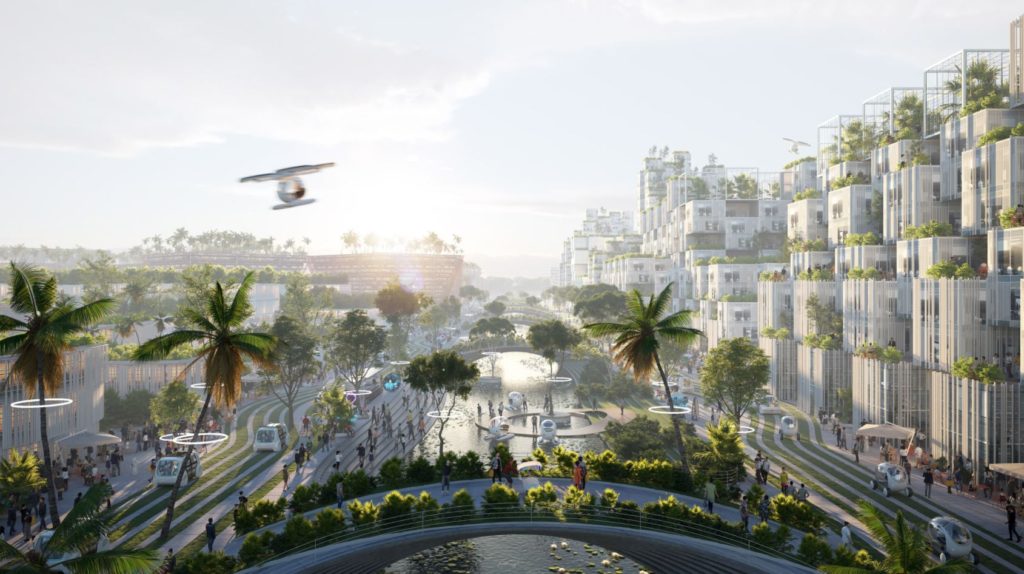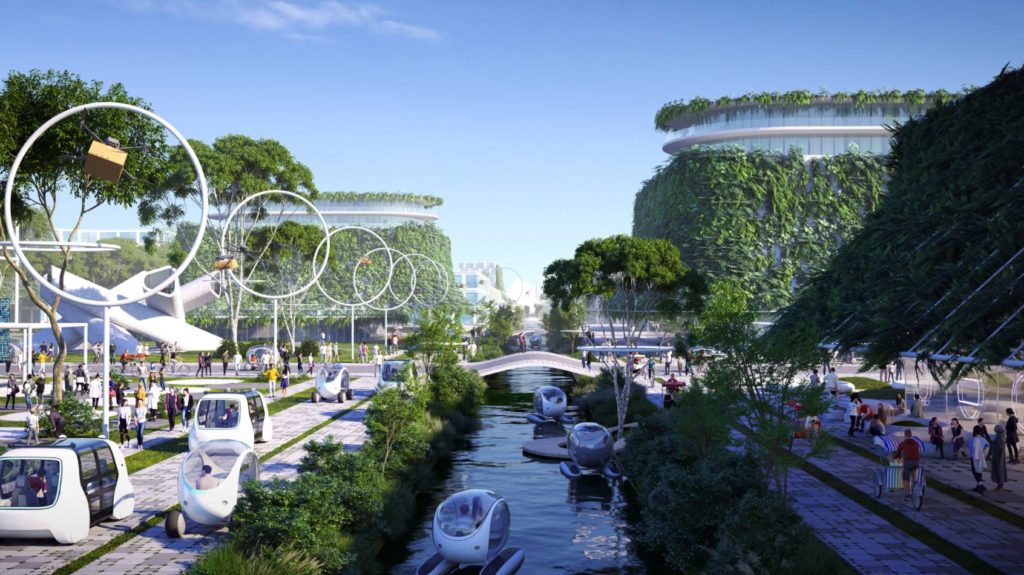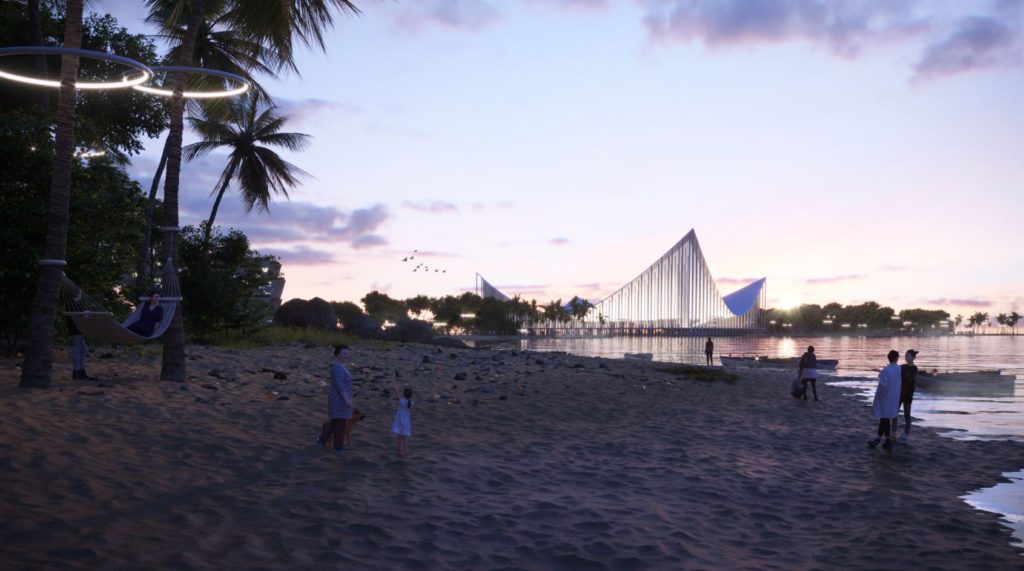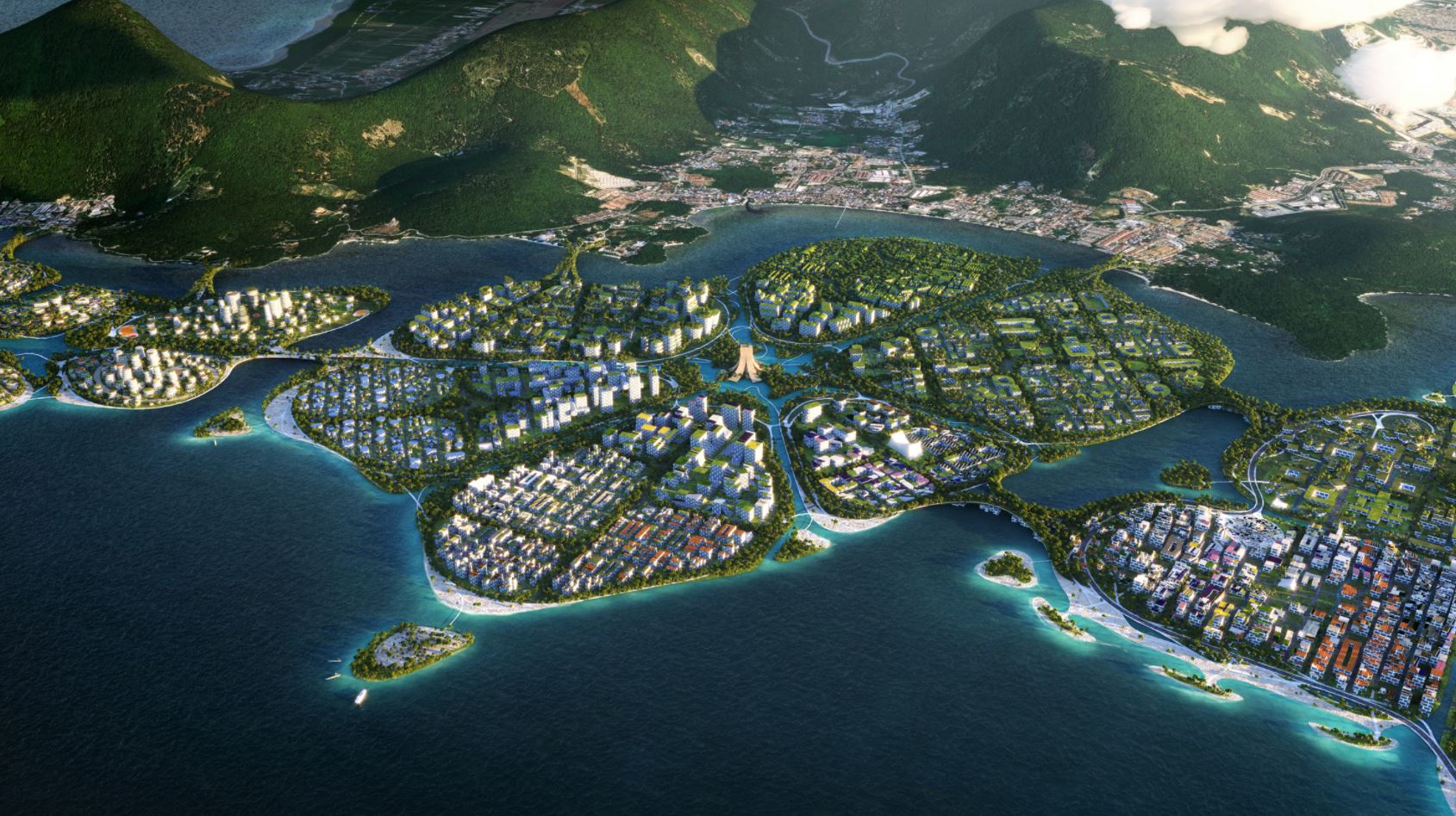“Biodiver City” is a proposed project by the Bjarke Ingels Group (BIG) to create a small chain of biodiverse island habitats off the northwest coast of Malaysia to alleviate overcrowding on the country’s mainland.
The Malaysian island of Penang, typically known for its beaches and food, is set to host this new project, where three new islands will be created to house some 15,000 people and fix what authorities describe as “a lack of economic opportunity.”
Selected ahead of 5 other finalists in a competition held by the Penang State Government, BIG’s BiodiverCity proposal is meant to, “be a new sustainable global destination where cultural, ecological and economic growth is secured and where people and nature coexist in one of the most biodiverse places on the planet at the southern shore of Penang Island.”
As part of Penang’s 2030 vision, the project is being promoted as a green alternative to their current living situation, where the lilypad-shaped islands proposed — roughly 4,500 acres each — will be car-less with a renewable energy focus.
As BIG’s founder stated, “if Penang is defined by its rich cultural diversity and its abundant biodiversity, we would like to envision the Penang South islands as an archipelago where the two can coexist in a human-made ecosystem, expanding and enhancing one another.”
But the “Biodiver City,” also known as the Penang South Reclamation (PSR) project, hasn’t necessarily been welcomed by everyone. Some residents of the island say that the project will be an environmental disaster while others have personal concerns.
As several of the island’s businesses are made up of fishermen and other sea-dependent people, they worry that the project threatens to undermine their livelihood.
Mahadi Md Rodzi, who chairs the Penang Fishermen’s Association and represents over 6,000 fishermen, has been one of the most vocal critics of the project saying, “the area is rich in prawns and fish. If you build islands, what we will see is permanent environmental degradation.”
Even when compensation was offered to the fisherman — 20,000-ringgit ($4,950 U.S. dollars) — they still refused to accept the offer, saying the Environmental Impact Assessment (EIA) report used for the project failed to accurately assess the potential environmental damage.
Despite their concerns, however, the project appears to be moving forward.
Biodiver City In Pictures
The island districts are projected to support between 15,000 and 18,000 residents each — every island will be sustainable with a heavy focus on renewable energy, local water resources, and waste management.
- To make Biodiver City an environmentally friendly place, the islands will be connected by an autonomous water, air, and land-based transportation network in an effort to reduce the need for cars and prioritize bikers and pedestrians.
- All the buildings and districts will be surrounded by a web of ecological corridors called buffers, which are between 50 and 100 meters in width. These corridors will be used to preserve natural habitats and support biodiversity.
According to the master plan, the first island is called Channels where there will be an area for government and research — called Civic Heart — and a Cultural Coast district that will resemble George Town, Penang state’s capital.

The heart of the island will be a 200-hectare digital park, which will invite residents and guests to “explore the world of technology, robotics and virtual reality.”

BiodiverCity’s second island, The Mangroves, will be dedicated to business-focused districts. It will have a Central Park district that will be surrounded by a series of mangrove forests.

The third island is called The Laguna and it will consist of a residential area and eight smaller islands that will act as a buffer to the world of technology and serve as a marina.

Bjarke Ingels — “biodivercity” will have an integrated system of localized water resources, renewable energy and waste management, tied altogether in a human-made ecosystem. rather than design a city for cars, we designed biodivercity for waterways, rail and different kinds of personal mobility, forming a multi-modal environment of movement. the resultant urban landscape will be a celebration of penang’s position as a truly global crossroads of the world – economically, ecologically and socially.”
Bjarke Ingels Group (BIG) and Bjarke Ingels on sustainability – Is it merely a mirage?
It’s pretty clear that modern architects are shifting their focus towards a greener industry in an effort to merge the environment with modern design concepts — but not every company that etches the words “green” somewhere on a project’s title should be hailed as the gold standard of development. More often than not, these firms project an appearance of greenness but are still beholden to the same wealthy real estate developers that wouldn’t have batted an eye towards sustainability just a decade ago.
And make no mistake, Bjarke Ingels has been criticized for this very thing.
Meeting with far-right Brazilian President Jair Bolsonaro in 2020, the two discussed economic opportunities for Brazil in order to, “change the face of tourism.” The meeting shocked the architecture world and received some heavy criticism as many questioned why the supposed leader in sustainable architecture would be meeting with one of the world’s most avid climate deniers. Known for his racist undertones and homophobic nature, Bolsonaro has actively rolled back environmental protections for the Amazon rainforest since his election and has allowed mass deforestation and the clearing of indigenous communities on an unrivaled scale. Even more so, his authoritarian tendencies and open disdain for the activists who protest his agenda of deforestation have made him a universal enemy of the climate movement, who rightly feel threatened by an architect claiming to represent a green agenda who collaborates with him.
But Bjarke Ingels has defended this criticism, saying that it’s not his place to judge the client but to offer sustainability to everyone regardless of where they stand politically. But as many Brazilians have pointed out, sustainable projects and tourism are often just a means to prioritize wealthy endeavors at the expense of the poor. Additionally, others have said that it sends the message that no matter how corrupt or anti-environment your agenda might be, there’s always a design firm willing to help you greenwash.
Resilience and Biodiversity? Penang may already have it
It’s no secret that mega-developments have destroyed communities. So while it’s hard to doubt the engineering prowess of the project, one has to ask “why” such a project is moving forward.
Because if the goal is to build resilience and biodiversity, it seems that Penang may already have it.
According to The Habitat at Penang Hill, there’s a 130-million-year-old ancient rainforest that overlooks the island and has one of the richest and diverse habitats of any rainforest in Malaysia.
“Over millions of years, Malaysia’s rainforests have nurtured a tremendous diversity of flora and fauna and has served as home to countless unique mammal and bird species. Scientists estimate that they host around 20% of the world’s animal species. Recognized as one of the world’s biodiversity hotspots, Conservation International listed Malaysia as one of 17 countries described as “mega diverse”.
Closer to us, the Penang Hill virgin jungle reserve area, on the fringe of which The Habitat sits, is believed to be part of Malaysia’s treasure trove of prehistoric rainforests dating back 130-million years old. Besides its rich biodiversity, it plays an important role as primary water catchment area for Penang island.
Our rainforests also provide essential ecosystem services for sustenance of life including climate regulation, water & nutrient recycling, air purification, carbon storage and soil stability.”
THE HABITAT PENANG HILL
So if it’s not about biodiversity, what is it about?
Well, it’s hard to say exactly what Bjarke Ingels was thinking when he proposed the Biodiver City, but what’s easy to understand is that given the current corporate environment and lack of oversight, it’s not out of the question to think that ulterior motives exist.
In recent years, the urban residential market for high-end apartments has skyrocketed. And when huge developments are built inside a city center, it often has devastating consequences for the surrounding community where, unfortunately, the needs of the wealthy are often prioritized over everything else. Yet, at the same time, as climate change has arrived at our doorstep and is now impossible to ignore, it seems that piecemeal solutions like rooftop gardens and solar panels are just “people-pleasing techniques” rather than serious responses. In that aspect, large developers who would otherwise be coerced into adopting stricter building codes, waste management techniques, and regulations to address climate change, are enticed by offers from developers like BIG who offer an appearance of greenness but don’t stray from corporate ethos. In other words, it’s a shortcut that the public won’t argue with because, well, it looks green and has cool buzzwords — hints the name “Bio-Diver-City” as a play on the word “biodiversity.”
But what about the Penang South Island Reclamation and the Penang South Island Project as a means to reduce overcrowding? What about the environment for the Biodiver City?
Here’s what I don’t doubt — I don’t doubt that the islands themselves will be sustainable once complete. I don’t doubt that it’s engineered properly and I don’t doubt that it will be a fantastic place to live in 30 years. What I do doubt, however, is that it will somehow reduce overcrowding, meet environmental objectives, and fix Penang’s problems.
Why? Because history tells us otherwise.
And many in Malaysia agree.
Evelyn Teh, an environmental researcher in Penang, has criticized the Biodiver City for this very thing: “The government risks putting too much focus on a massively expensive and environmentally destructive project that will only benefit a small group of people at the expense of the wider population during an unprecedented economic crisis.”
And she’s not wrong.
Although the project does have some affordability options in play for its residential units, history tells us that these types of developments do nothing for the people that already live there.
Take, for example, the Manila Metropolitan Area — a megacity along the Philippine coast — which has started its own reclamation project that’s now lasted over 40 years.
Despite a few economic successes, the project as a whole looks more like a new city rather than an expansion of the existing one. And for those that live along the coastline, well, they’ve lost everything.
As much of the reclamation project has centered around business developments, very little has been given to the public and coastline residents have been asked to leave.
When compensation was offered to the displaced families — a meager 15,000 Philippine Pesos or roughly 300 USD — there was zero thought given to how and where these families would relocate. The result? The livelihood of an entire fishing community destroyed.
One civic group representative within Manila said, “In all aspects, this reclamation projects will not serve the best interest of our people. It is equally detrimental to the environment and especially to those people who live along the coast.”
And Manila isn’t alone in its failures. Land reclamation projects and artificial islands have failed all over the world and not a single one of them has lived up to their original expectations.
Seoul’s Songdo utopian smart city was built in the early 2000’s and was supposed to house 300,000 people — the real number? A ghost town of 70,000 inhabitants.
Dubai’s islands are sinking back into the sea and all construction has been halted.
Jakarta’s started on a $40 billion reclamation project that was eventually scrapped, but not until the area became unfishable.
All of these reclamation efforts can be considered greenwashing — making something that is inherently bad for the environment and people appear green and sustainable to sell it. And unfortunately, this is becoming more and more common in a time of climate change.
So what’s the answer for the Biodiver City? The answer is to look at the underlying issues and ask — Resilience for whom? Sustainability for whom? Because if the goal of these projects is to address these issues, then there are far better solutions.

